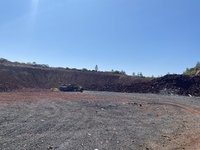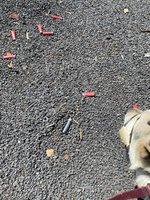I_I_am_not_a_cat
Sapling
This is my first post to this forum and this is my first yamadori or bonsai experience. I have collected some yardadori saplings from my yard, but they have been volunteer elm and maple saplings/seedlings. Many have survived, but not all of them and they are not in bonsai soil, nor wired into training pots or styled at all other than initial cleaning. I am mostly just going to let them grow for a while longer.
Moving onto my first yamadori:
Collected 3 weeks ago in the Cascade range at about 5000 ft elevation. I am on the Eastern side of the mountains, right were the landscape changes to High Desert scrub and Juniper. I have read websites and watched videos for a couple of years now so I thought I knew what I was doing. Apparently not so much.
I got a permit from the forest service and drove up into the mountains a little bit. I ended up finding this beat up Ponderosa Pine in a cinder pit, surrounded by broken glass, trash and a shot up, burnt out car. I am fairly certain that the main trunk was removed by shooting at it.
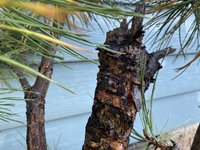
Unfortunately, the digging didn’t go so well and I didn't get a root ball--either I did not dig deep enough or my technique was bad. As you can see in the images, it was growing in cinder.
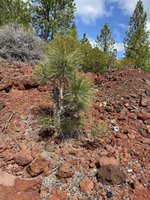
As I was digging, what I thought of as the root ball kept falling away. By that point I was invested, so I tried to salvage the situation.
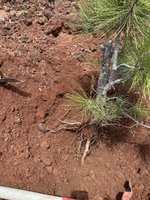
What roots it had I got wet, put into a 5 gallon bucket wrapped in a wet towel with some of the cinder soil. Once I got it home, I made my next mistake and mixed the cinder with some of my garden soil, thinking that would help keep what roots I had protected. I thought I knew better, but my brain was not quite tracking correctly.
The next day, based on a suggestion from the reddit bonsai community I repotted it into straight pumice. I wired/tied it in after the fact--apparently I had forgotten everything I had read or watched up to this point. It has been sitting in full sun ever since (but I have watered it whenever the pumice is almost dry at the roots) but now I am questioning that decision after reading on here about other's misting regimes.
Now it is starting to get yellow needles, it is also putting out candles.
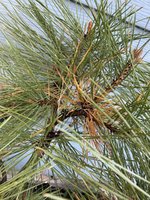
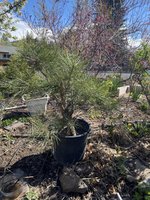
Things I have learned so far:
Moving onto my first yamadori:
Collected 3 weeks ago in the Cascade range at about 5000 ft elevation. I am on the Eastern side of the mountains, right were the landscape changes to High Desert scrub and Juniper. I have read websites and watched videos for a couple of years now so I thought I knew what I was doing. Apparently not so much.
I got a permit from the forest service and drove up into the mountains a little bit. I ended up finding this beat up Ponderosa Pine in a cinder pit, surrounded by broken glass, trash and a shot up, burnt out car. I am fairly certain that the main trunk was removed by shooting at it.

Unfortunately, the digging didn’t go so well and I didn't get a root ball--either I did not dig deep enough or my technique was bad. As you can see in the images, it was growing in cinder.

As I was digging, what I thought of as the root ball kept falling away. By that point I was invested, so I tried to salvage the situation.

What roots it had I got wet, put into a 5 gallon bucket wrapped in a wet towel with some of the cinder soil. Once I got it home, I made my next mistake and mixed the cinder with some of my garden soil, thinking that would help keep what roots I had protected. I thought I knew better, but my brain was not quite tracking correctly.
The next day, based on a suggestion from the reddit bonsai community I repotted it into straight pumice. I wired/tied it in after the fact--apparently I had forgotten everything I had read or watched up to this point. It has been sitting in full sun ever since (but I have watered it whenever the pumice is almost dry at the roots) but now I am questioning that decision after reading on here about other's misting regimes.
Now it is starting to get yellow needles, it is also putting out candles.


Things I have learned so far:
- Just because I have read about it doesn't mean I know it (lol).
- Digging in straight cinder is not easy, and root balls do not seem to hold together in that medium.
- I might be wrong about the second section.
- Be prepared with everything you might need before collecting.
- I did not have a plan, other than collect a tree that day.
- I did not have pumice or bonsai soil on hand
- I did not pre-wire the pot and only realized how unstable it was after the fact.
- Post-care is a whole subject that I barely scratched the surface of.
- Should I move it into a space that gets a bit less sun?
- It is starting to get hot here, and our spring rains are starting to fade out.
- I can move it under the eaves of the south facing wall of the house, where it will get shade from the apple tree in the afternoon.
- I can move it a bit more under the sand cherry it is in front of in the picture, where it will be a more dappled shade but still get direct morning and late afternoon sun.
- How often should it be misted? I do not have any way to set it up on a timer, but can figure that out if the BonsaiNut experts say that is best.


